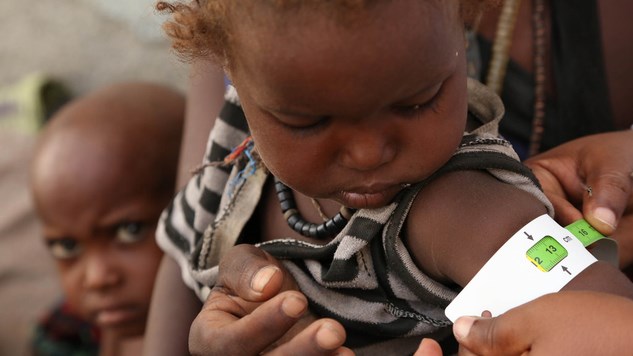
Monday February 1, 2016
"Based on the latest UN figures, the report estimates 60 million people will be impacted by El Niño this year with many suffering health consequences"

Health worker examines an Ethiopian child at a temporary emergency rub hall tent built by UNICEF after the failure of rains caused by El Niño. (Photo/Unicef Ethiopia/Flickr).
ETHIOPIA is struggling from its worst drought for 30 years with millions in dire need of life saving aid, UN Secretary-General Ban Ki-moon warned Sunday.At least 10.2 million people need food aid in Ethiopia, a figure the UN has warned could rise sharply, as “forecasts indicate that it could double within months” casting a fifth of the population into hunger. Floods and failed rains caused by the El Nino weather phenomenon have sparked a dramatic rise in the number of people going hungry in large parts of Africa, even as Ethiopia is of special concern.
The weather phenomenon, which affects rainfall patterns and temperatures in many parts of the globe, has wreaked havoc across many parts of Africa.
While some areas are experiencing the worst droughts in decades, others are at high risk for flooding as above-average rainfall pounds.
A lot of recent attention has focused, and rightfully so, on the devastating and lasting impact that this will happen on Africa’s agricultural produce and, therefore, food supply. After all, the vast majority - 95% - of Africa’s agricultural produce is rain-fed.
Though adverse climate conditions are expected to peak in January 2016, another less reported, but equally devastating, impact of El Nino in Africa will be the health plagues that are to come and, with poor healthcare services and inadequate resources in the majority of African countries, it’s going to be bad.
The World Health Organisation (WHO) have just released a report which outlines some of the most worrying health predictions:
- Extreme drought and acute water shortages affecting 30 million people in southern Africa will lead to increased malnutrition and diarrhoeal diseases.
- In the Horn of Africa, the devastating drought which has affected 22 million people has been followed by unusual heavy rains causing a high risk of vector-borne disease and communicable disease outbreaks, especially among displaced populations and those with high levels of malnutrition.
- In Somalia there are about 4,000 cases of acute watery diarrhoea and cholera were recorded with 85% of the cases being children under five years of age.
- Heavy rains and flooding in eastern Africa with a risk that the ongoing cholera epidemic - 12,000 reported cases so far - in Tanzania will spread, and other countries may experience cholera outbreaks.
- In Somalia, Kenya and Tanzania there is a specific concern on the possible resurgence of the Rift Valley Fever. Displacement and crowding due to floods could also lead to increased transmission of other communicable diseases such as measles and meningitis, especially in the meningitis belt zone.
- Ethiopia is facing the worst drought in 30 years. Already, close to 400,000 children are suffering from severe acute malnutrition and require therapeutic feeding. Water-borne and other communicable diseases such as cholera, measles, scabies and meningitis could also rise due to shortage of water and poor sanitation and hygiene conditions combined with malnutrition and population displacement.
- Southern Africa is witnessing some of the worst drought in over 50 years and the hottest temperatures in more than 100 years. More than 5 million people are expected to experience food insecurity during 2016 in central Mozambique, southern Malawi, southern Madagascar, south-eastern Zambia, Zimbabwe, Swaziland, Botswana, Lesotho and South Africa.
Below-average rainfall is forecast during the main growing season (December-April) with a risk for those countries of facing two consecutive bad growing seasons. Most at threat from immediate food insecurity and associated malnutrition are Malawi (close to 3 million people), Zimbabwe (1.5 million), Lesotho and Madagascar.